Ayesha Vera Yu
Co-Founder, Advancement For Rural Kids (ARK)
Fellow project website: www.ruralkids.org
Through neighborhood barter markets and other self-organizing patterns, Ayesha Vera Yu helps poor rural Filipinos quickly banish hunger and take charge.
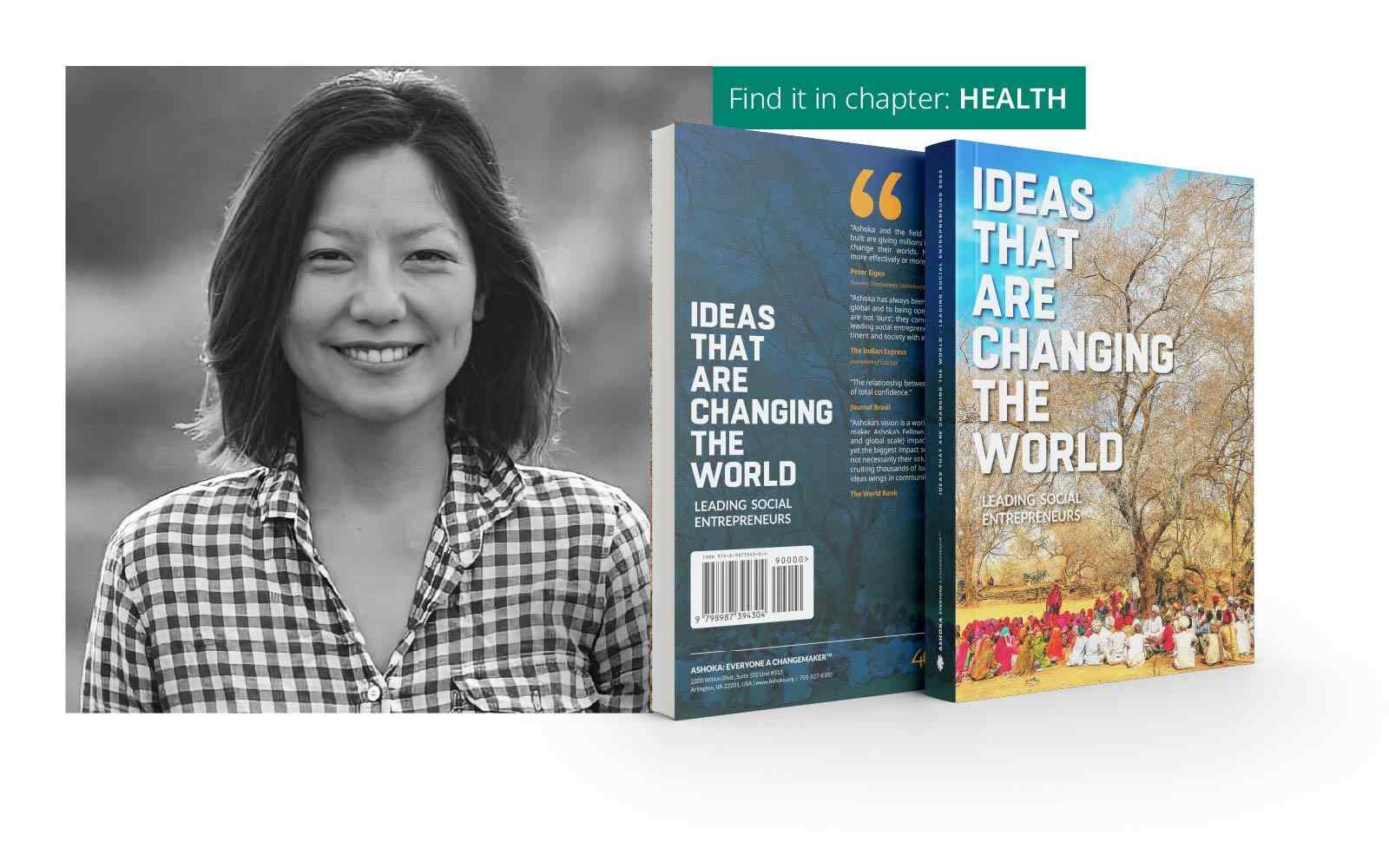
THE NEW IDEA
Ayesha, who left a successful career in banking to take on rural hunger in the Philippines, inspires hungry, discouraged rural communities to adopt new patterns of growing and sharing food, which leads to their taking charge far more broadly.
Rural food producers in the developing world often go hungry themselves. In the Philippines, over a third of rural residents, most of them fisherfolk and farmers, live in poverty and struggle to feed their own families. Their children often go to school hungry, suffer malnourishment, and risk dropping out.
Ayesha’s many ideas changed that. Her first innovation was a co-investment approach that partners with schools and parents, starting in 16 Filipino rural communities, to create a nourishing school lunch program by leveraging the communities’ own resources. It sparks parents to plant organic vegetable gardens in their backyards and schools to plant their own gardens. Her next innovation was Feed Back, a simple but powerful model that helps rural residents grow and exchange their own food through backyard farming and self-organized exchanges that feed the entire community.
After four weeks of growing, community leaders organize a weekly collective barter market, a celebratory event that turns out the whole village. In this way, community members end hunger and malnutrition in just five weeks. Soon after, they are producing surplus food they can sell to neighboring villages, creating a new income stream and a new sense of self-determination.
Feed Back has been implemented by 35 communities across six provinces of the Philippines, securing 100% of at-risk families in these areas, strengthening those communities as a whole, and enhancing food security in other towns. The program will expand to over 200 rural communities in 2023, reaching 250,000 people. Ayesha and her team are working with government and private partners to reach a million in the next three years.
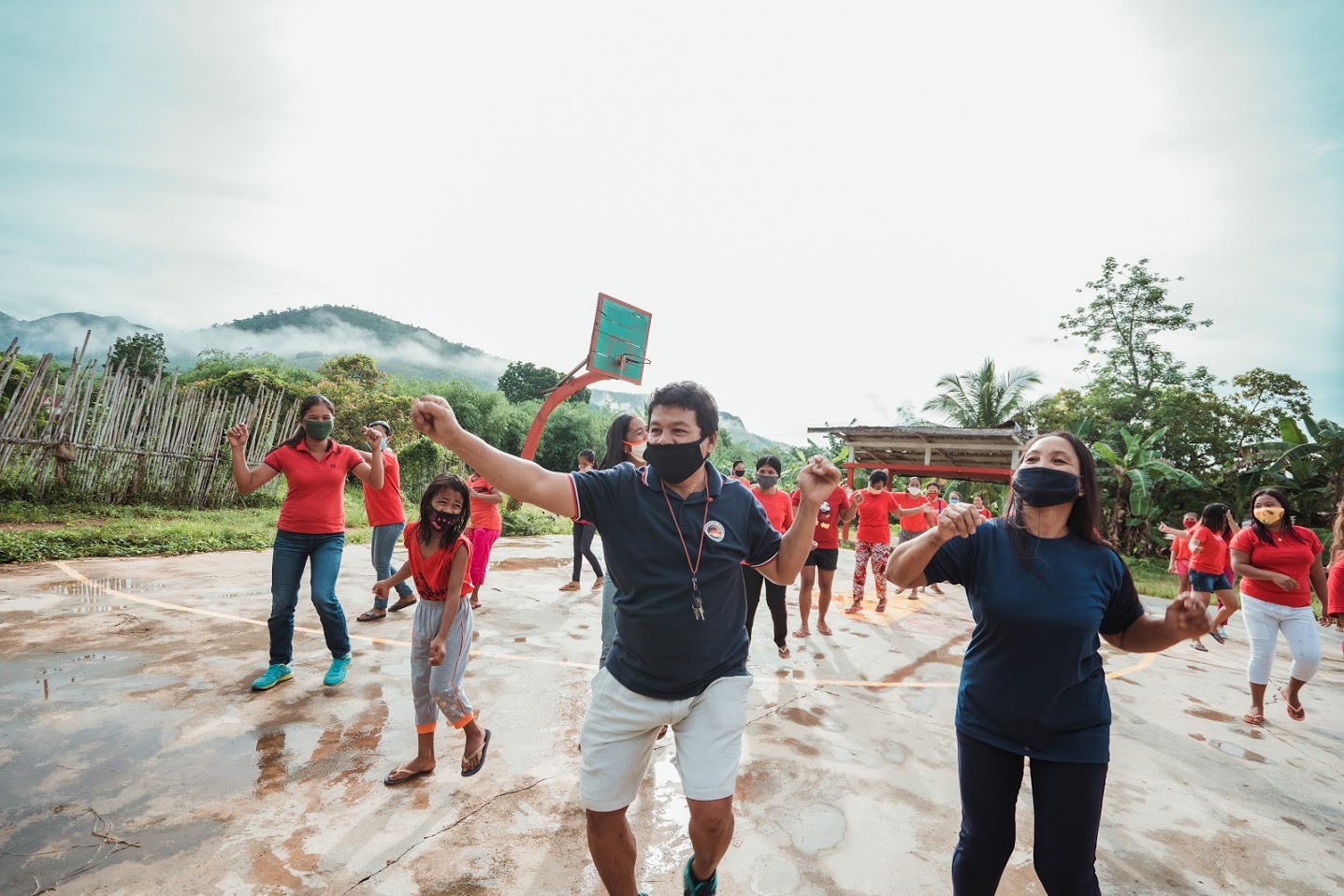
vegetable costume contests to kick off the planting cycle.
THE PROBLEM
Two billion people around the world suffer from chronic hunger. In the Philippines, half the population has gone hungry, which especially harms children. Over a third of rural Filipinos live in poverty. The majority are farmers and fisherfolk—the lowest income earners and the most vulnerable to food insecurity.
Filipino farmers typically don’t own their land. Two-thirds of agricultural land holdings in the Philippines are rented to tenant farmers who contract with landowners, mostly growing rice and corn for private companies. But chemi-cal-intensive farming techniques and climate and supply disruptions make this an increasingly risky, disempowering proposition. Terms are dictated by landowners and middlemen. Farmers are dependent on commercial seeds, pesticides, and fertilizers, and often must borrow at high, e.g., 20%, interest to buy seeds and chemicals.
“When the Spanish colonized the Philippines, they gave out big land grants,” said Ayesha. “When Americans came, they kept the same feudal system intact, and it hasn’t changed. What gets produced on the farms of big landowners is for export. The rest of the country is fed by smallholders. It used to be that small farmers always turned a profit because they produced all the inputs, they needed themselves. But chemical farming has created deep poverty. Smallholder farmers have to borrow to get the inputs, and if a storm wipes out their cash crop, they can never repay.”
Focused on their cash crop, these farmers have turned away from the traditional practice of raising other produce and animals for subsistence alongside cash crops, so they have to buy food for their families instead of growing it. This often means borrowing more money, especially during the rainy season when farmers have to buy inputs for planting, which also coincides with the start of school. This is the leanest time for them, when their children are more likely to go to school hungry and malnourished, leading many to drop out and seek work.
The problem is a global one. Farmers in many developing countries struggle to feed their families, and a quarter of a billion children worldwide aren’t in school.
This year, Russia’s invasion of Ukraine disrupted the global supply chain, making matters worse. Food and fertilizer costs tripled, resulting in a hunger crisis in the Philippines and elsewhere. Add climate disruptions, typhoons, and the pandemic, and rural farming and fishing communities can end up feeling helpless and hopeless.
Many have at least some access to food aid (though some rural communities have none). But external aid is not a comprehensive solution and does not build lasting food security. Government and philanthropic programs depend on scarce funding, and can only help until the money runs out. Citizen organizations offer food augmentation programs that send vegetable packs from farmers to beneficiary families, but the relief they provide is temporary. One important Philippine government program fed at-risk kids in public schools during 2018-2019, but only a portion of hungry or malnourished children qualified.
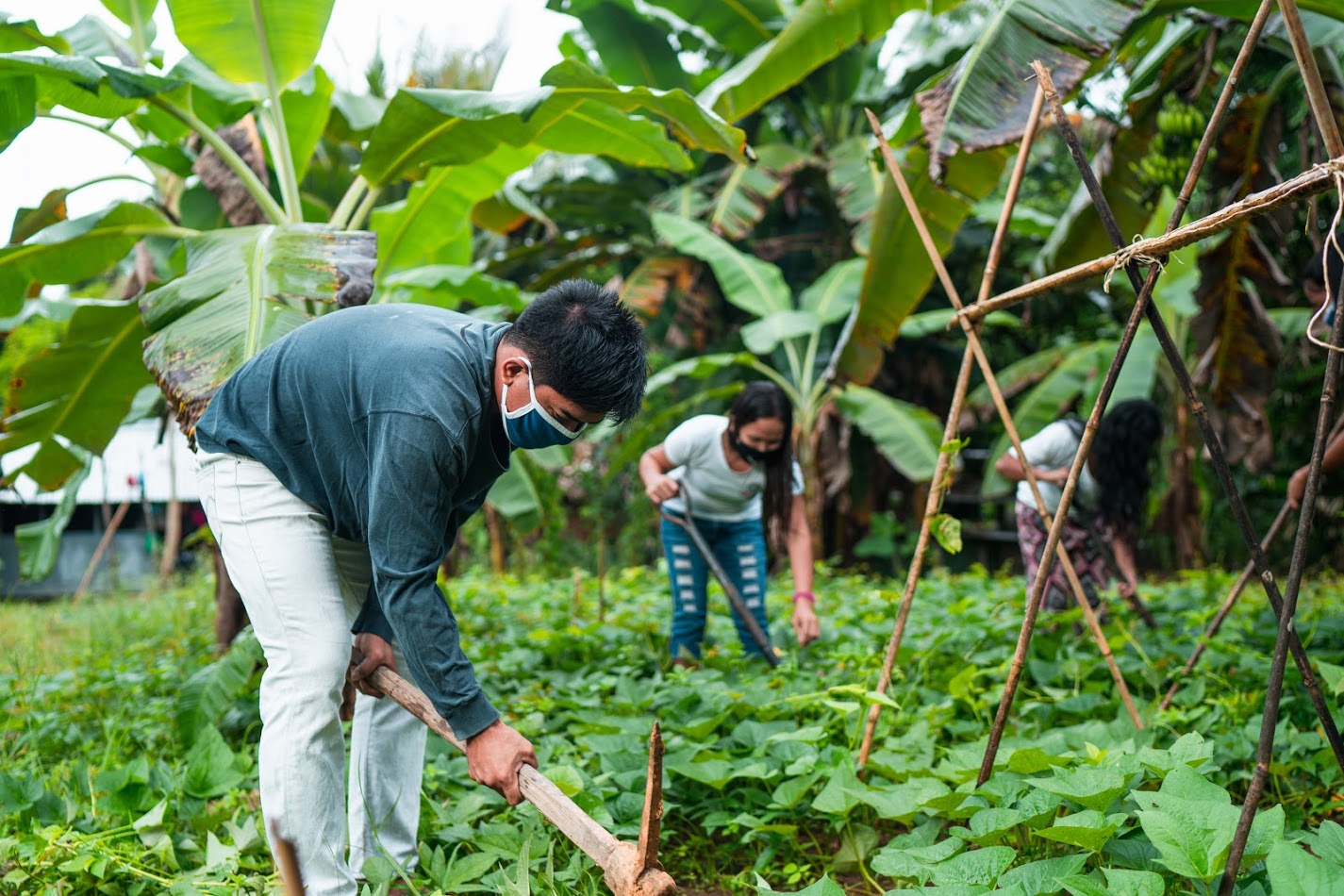
million meals comprising locally sourced vegetables and protein.
“Relief packs and handouts are good in an emergency, but they don’t solve chronic hunger,” says Ayesha. “Community pantries that require outside food aren’t sustainable. If there is no path for the community to grow the food it needs, they fail in the long term.”
At the root of rural hunger, malnutrition, and poverty is the loss of agency of rural people and their dependence on commercial inputs and volatile markets for monoculture cash crops. Treating them as passive aid recipients fails to address those problems.
As Ayesha recognized, rural farmers and fisherfolk are the key resources for solving their own food security problems. They are more than capable of feeding themselves and even creating surpluses once they step outside of a system that has failed them. So, she partnered with them to build a new system to step into.
THE STRATEGY
In 2009, Ayesha founded Advancement for Rural Kids (ARK), to find new structures, including co-investments that empower at-risk communities to solve their own hunger and malnutrition challenges. Community members lead and own the solutions. They have the ball, not outside forces.
Parents and teachers create backyard and schoolyard gardens, raising vegetables and livestock to feed the children. And they inspire others in the community to do likewise. Pooling what they produce yields lunches with full, balanced nutrition for every child who attends school, every day that school is open.
The lunches aren’t free, but because the community is providing almost all the inputs, they cost less than 5 cents a day. Parents in poor rural communities can afford to pay that themselves, so they buy into the program from the beginning as co-investors, rather than relying on outside aid.
Each parent makes substantial in-kind investments, taking time off from work to come to school and make lunches, and learning to use Excel to track every dollar and impact. ARK helps them integrate and take over the program entirely within three years, so the system becomes fully self-sustaining, owned and operated by the community, with no outside input or funding needed. In time, as families learn to increase their yields, they produce surpluses they can sell, giving them an additional income stream.
ARK Lunch has delivered one million lunches and counting. In many schools, it reduced prior malnutrition rates from 30% or more to zero and raised school attendance to 100%.
In 2019, the program was poised to scale up nationally. But when the covid-19 pandemic hit, schools closed. Many villages, including the entire island of Luzon, went into lockdown. Mobility and business activity were severely restricted. Many fisherfolks were prohibited from fishing, and/or from selling fish. Rural families were again at risk.
Advancement for Rural Kids creates a path for rural communities to solve hunger, get kids back to school, and be self-sustaining starting with 5-cent school lunches. - TECHINASIA
So, ARK pivoted. Ayesha created a new co-investment program called Feed Back that applies the same basic principles as ARK Lunch to feeding the whole community, pooling food grown by community members, and delivering it through village market exchanges instead of schools.
Like ARK lunch, Feed Back is 100% community-led and – owned. It starts with recruiting local community leaders who go door to door, asking residents to plant organic gardens with at least three kinds of vegetables, and providing advice and support. After gardens have been growing for four weeks, the community organizes a weekly collective barter market in a central village space. Families bring three kinds of produce to exchange and take home a nutritious array of 20 different kinds. Hunger and malnutrition are gone by the time of the first market, just five weeks into the program
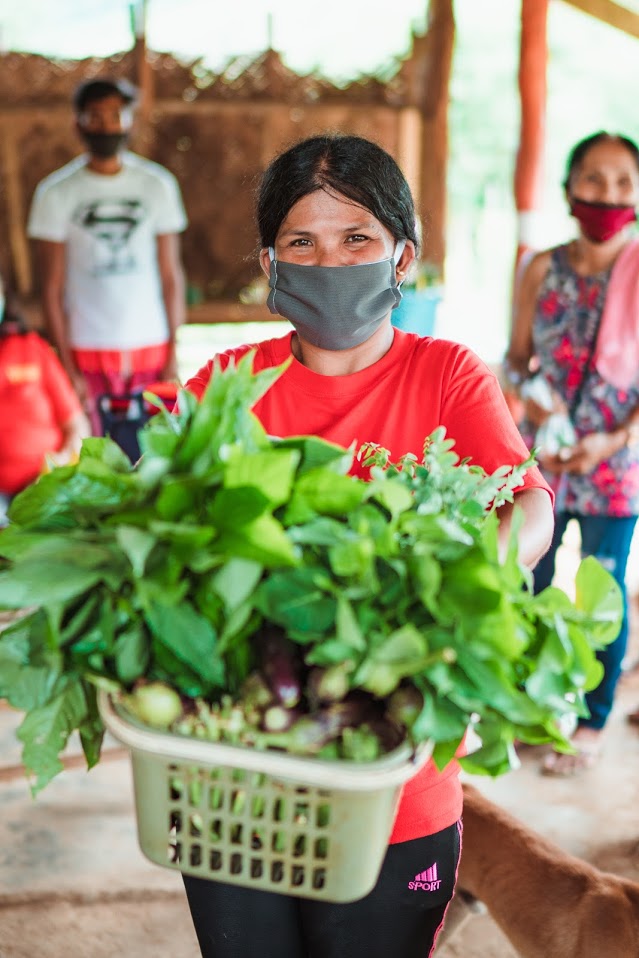
The markets are much more than a food exchange; they’re communal, festive affairs (known as “Fiesta Feed Back”) that engage the whole village and knit it together. Everyone’s contribution is valued, and all produce is weighed, tracked, and accounted for. Small incentives sweeten the pot and strengthen participation. For example, for every $1 worth of vegetables a family brings to the weekly market, they get a raffle ticket for a prize.
It’s not a line to receive outside aid; it’s a joyful celebration of what the community is doing for itself. Instead of a disempowered relationship with landowners and cash crop markets stacked against them, families get to invest in themselves and rely on each other, building a stronger, more unified, resilient community.
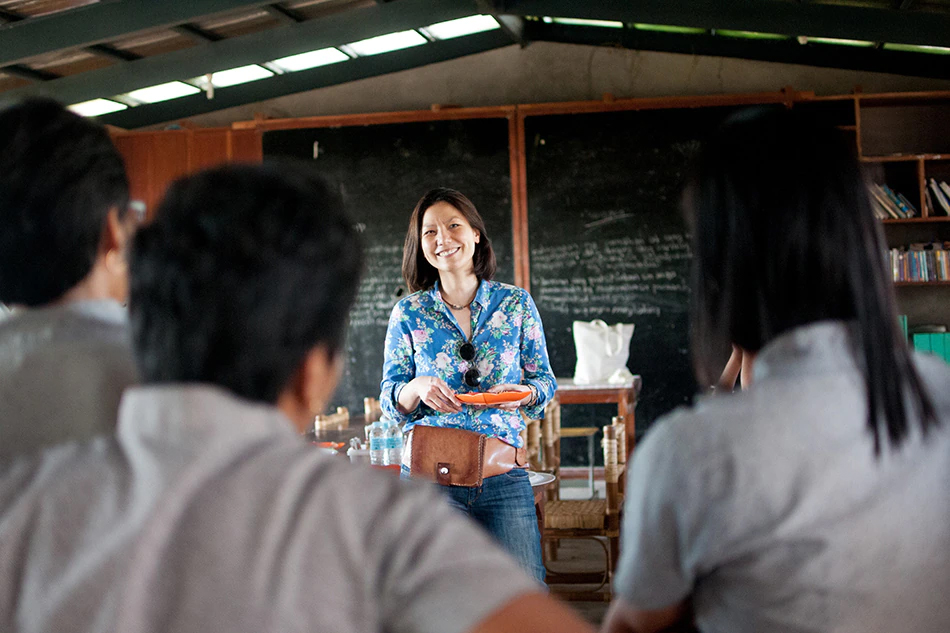
grow organic food to provide school lunches and cut family hunger.
“To solve hunger and create food security, you have to dismantle the existing inequitable structure,” Ayesha said. “Aid organizations are sincere, but they have this idea that they know better. It’s a holdover from colonialism, the notion that they can solve it for you. There is an underlying level of racism and classism. Those with access to capital and influence over policy tend not to embrace the idea that people have the solutions. But that’s the key to solving big, structural problems.”
The markets continue, especially, getting families through the hazards of the rainy season. Ayesha’s program is even more helpful when a community is hit by a typhoon (some participating communities were hit by successive ones) or other unforeseen disruptions.
After a disaster, Feed Back communities are able to rebuild their food systems and local economies quickly.
The benefits are lasting and self-sustaining. For almost all Feed Back “graduates,” the shift in behavior is permanent. Many become entrepreneurs, producing food and organic fertilizer beyond what they need for their own use, and selling it for extra income.
For example, in the rural village of Traciano, which was hit by Super Typhoon Odette in 2021, 94% of residents are still harvesting from their backyards a year after graduating from the Feed Back program. Not only don’t they go hungry, but two-thirds of them also derive 25% of their income from selling the surplus.
In the past two years Feed Back has taken root in 35 communities across six provinces of the Philippines, securing 100% of at-risk families in these areas. About 325,000 kilos of food have been exchanged so far. The program is poised to roll out nationwide to over 200 at-risk communities, reaching 250,000 people by 2023. ARK continues to work with Feed Back “graduate” communities to further build their skills and connect them to wider markets for their surplus, helping fight hunger in other parts of the Philippines.
Ayesha and her team are in high-level dialog with the Philippine government on how to leverage Feed Back to end hunger and malnutrition nationwide. In the previous administration, Feed Back became the only sustainable food security solution endorsed by Pilipinas Kontra Gu-tom (Philippines Against Hunger), a major consortium of government agencies, corporations, and foundations. ARK is now attracting wide support, ranging from the Rotary Clubs in the Philippines to major idea hubs including Google and Facebook.
Those relationships are a conscious effort to “positively influence how corporations, foundations, and governments partner to create truly sustainable solutions and systems,” Ayesha says. She wants them to embrace new models in which beneficiaries are “trusted and treated as true partners, solutions come from within, communities implement and fund them on their own.”
From once being seen as extra work, backyard farming has become a community activity. Those who decided to join [the ARK program] danced Zumba on basketball courts and held vegetable costume contests to kick off the planting cycle. And families make a day out of going to market. - CNN
To scale up further, Ayesha is working on a “playbook” communities can use to replicate the Feed Back model themselves, as opposed to working directly with ARK trainers. That lowers costs and can extend the program’s reach. Ayesha’s current goal is for Feed Back to reach 1 million people in the next three years, and from there to keep scaling globally, so farmers and fisherfolk never go hungry again.
THE PERSON
During the Marcos regime, the Philippines was under martial law from 1972 to 1981. Ayesha’s parents decided to emigrate and moved the family to the U.S., settling first in Oakland, California, then in New York. Ayesha attended private schools and was accepted to a top New York charter school, but she was told she would need to repeat a grade. Already frustrated by the covert discrimination she encountered as a Filipino-American, Ayesha left in defiance and opted to attend public school for the first time.
There she encountered more racial and ethnic diversity and felt the desire to connect with her Filipino roots. She participated in Filipino-American activities in high school and at Mount Holyoke College, where she studied biochemistry and the politics of the developing world. She took an executive MBA degree from Columbia University and went on to a successful career in finance, becoming the youngest director at BNP Paribas, handling billion-dollar leveraged buyouts and mergers and acquisitions.
Her family had kept their farm in Capiz on Panay Island in the Philippines, and in 2006, Ayesha’s mom asked if she would invest. She agreed on the condition that the farm would become fully organic and sustainable. She began spending time in Capiz, using her biochemistry knowledge to help the farm transition. It became the first farm in Capiz to go back to organic and regenerative methods, emulating the way it had been run by her grandparents.
Recruited by a local teacher to help support the schools in Capiz, in 2008 she met with parents to ask them what they needed. She was surprised to learn the help they wanted most wasn’t with infrastructure or school supplies, it was to address student hunger. When Ayesha asked how that could be done, a parent answered, “the same way we fixed the roof – we partner!”
That was the germ of ARK. She quit her full-time job to focus on ending rural hunger and malnutrition by working with communities as full partners and leaders of the solution. She drew on her experience in finance to create new co-investment structures that provided the support rural communities would need to buy in and get started, and a pathway for their ventures to become self-sustaining quickly.